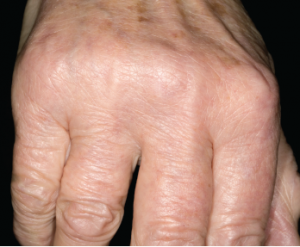
Close-up of the hand of a 68-year-old male patient affected by osteoarthritis
Dr. P. Marazzi / Science Source
Background & objectives: Hand osteoarthritis (OA), a highly prevalent disorder that may lead to severe pain and disability, is a heterogeneous disease with involvement of different joints and varying degrees of symptoms. The prevalence and incidence of hand OA vary greatly, depending on the definition used, population included and whether symptomatic hand OA or radiographic hand OA is analyzed.
Eaton et al. set out to describe the prevalence, incidence and progression of radiographic and symptomatic hand osteoarthritis (OA), and to evaluate differences according to age, sex, race and other risk factors in a longitudinal cohort of diverse individuals with or at risk of symptomatic knee OA (the Osteoarthritis Initiative [OAI]).
Methods: Participants were assessed for radiographic and symptomatic hand OA at baseline and year 4 to determine incident disease. A modified Poisson regression with a robust variance estimator was used to account for clustering of joints within fingers within individuals to estimate the prevalence ratios and relative risk estimates associated with participant characteristics.
Results: Among 3,588 participants with evaluable hand radiographs at both baseline and the 48-month follow-up visit, the prevalence of radiographic hand OA was 41.4%, and the prevalence of symptomatic hand OA was 12.4%. The incidence over 48 months was 5.6% for radiographic hand OA and 16.9% for symptomatic hand OA. Over 48 months, 27.3% of the participants exhibited OA progression.
The researchers found complex differences by age, sex and race, with increasing rates of prevalent hand OA with older age in both men and women, but with rates of incident disease peaking at ages 55–64 years in women. Women had higher rates of symptomatic hand OA, but only non-significantly higher rates of incident radiographic hand OA, than men. Women more frequently had distal interphalangeal joint disease, while men more frequently had metacarpal joint OA. Black men and women had lower rates of hand OA than white participants, but Black men had higher rates of prevalent hand OA than Black women at younger ages.
Weaknesses: Weaknesses of the study include potential selection bias for individuals with risk factors for knee OA, because this was part of the entry criteria for the OAI, including obesity, which may partially explain the lack of association with obesity with incident hand OA in this analysis. Also, the definition of symptomatic hand OA employed by Eaton et al. relied on using a homunculus and included stiffness and aching as well as pain, which may lead to misclassification bias.
Conclusion: Hand OA is a heterogeneous disease with complex differences by age, sex, race, hand symptoms and patterns of specific joints affected. Further research investigating the mechanisms behind these differences, whether mechanical, metabolic, hormonal or constitutional, is warranted.
For full study details, including source material, refer to the full article.
Excerpted and adapted from:
Eaton CB, Schaefer LF, Duryea J, et al. Prevalence, incidence, and progression of radiographic and symptomatic hand osteoarthritis: The Osteoarthritis Initiative. Arthritis Rheumatol. 2022 June;74(6).

